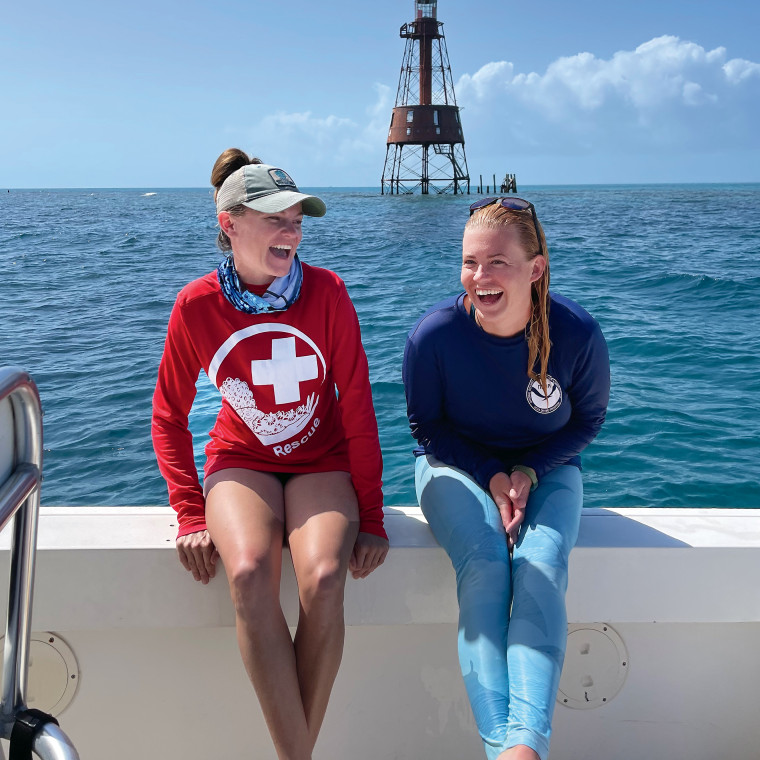Restoring Florida’s Coral Reefs
Open gallery

Home to lobster, sea turtles, fish, and thousands of other plants and animals, the coral reefs within the Florida Keys National Marine Sanctuary span nearly 300 continuous miles. But like other reefs around the globe, those in the Florida Keys are facing enormous stress. In recent decades, hurricanes, bleaching, disease, and heavy human use have wreaked havoc on Florida’s coral reefs.
WHO
Ananda Ellis BA ’09
Eva Ramey BA ’15
ACADEMICS
Ananda Ellis: BA in biology, Lewis & Clark | MS in marine biology with a focus on coral ecophysiology, California State University at Northridge
Eva Ramey: BA in biology, Lewis & Clark | MAS-MBC in marine biodiversity and conservation, Scripps Institution of Oceanography
FUN FACTS
Ellis and Ramey had never met before they joined Mission: Iconic Reefs in the Florida Keys even though they both grew up in Nederland, a small Colorado mountain town west of Boulder; both attended L&C and majored in biology; and both sought out Ken Clifton as their advisor and traveled to East Africa with him on separate overseas study programs.
WEBSITE
“Coral reefs are like underwater rainforests,” says Ananda Ellis, marine stewardship and monitoring specialist for the National Oceanic and Atmospheric Administration (NOAA). “They account for only 1 percent of the ocean’s volume but provide 25 percent of its biodiversity.”
In recent years, NOAA has partnered with federal, state, and local marine experts to launch Mission: Iconic Reefs, one of the largest investments ever undertaken in coral restoration. The 20-year project aims to proactively restore 7 specific reef sites within an underwater tract about the size of 52 football fields.
Both Ananda Ellis and Eva Ramey are part of the Mission Iconic Reefs team with the Florida Keys National Marine Sanctuary. Ellis leads the Mission: Iconic Reefs field operations team responsible for site preparation, maintenance, and monitoring of reintroduced healthy coral at the seven reef sites. Eva Ramey joined the Florida Keys National Marine Sanctuary to support coral reef monitoring research, data management, and analysis for Mission: Iconic Reefs.
Originally from the mountains of Colorado, Ellis was introduced to the oceans and snorkeling at an early age while on family vacations. Never having lost a fascination for the underwater world, she became dive-certified while completing her biology degree at Lewis & Clark.
Prior to joining the sanctuary, Ramey designed and led international science expedition courses for high school students. She has a diverse professional background as a terrestrial and marine conservation biologist, science educator, and scuba instructor.
Although she grew up far from the coast, having lived in the mountains of Colorado and the deserts of Namibia, Ramey has found that she’s most at home in the ocean.
Weather permitting, the mission’s monitoring teams motor out in small boats to one or more sites each weekday. Suited up in scuba gear, they dive 15 to 30 feet into vibrant turquoise water. Ramey is part of the team monitoring the Upper Keys sites. Team leader Ellis oversees the sites in the Lower Keys. “We’re the eyes of the reef, providing real-time information about what’s happening at each site,” says Ramey. “We’re taking close-up images that will be stitched together using computer software to create a photomosaic of the reef. This will allow us to track changes in coral communities over time.”
Ellis and Ramey both began to map their futures while at L&C on separate overseas study programs in East Africa. Led by Professor of Biology Ken Clifton, the programs introduced them to pristine reefs off the coast of Tanzania.
Both women say they feel fortunate being part of Florida’s multiyear coral restoration project.
“When a coral reef is thriving, it sounds like a bustling underwater city,” says Ramey. “You can hear all of the crackling, crinkling, and crunching sounds of the fish living on the reef. I can’t wait to hear that one day in the Keys.”
—by Pattie Pace
More L&C Magazine Stories
Lewis & Clark Magazine is located in McAfee on the Undergraduate Campus.
MSC: 19
email magazine@lclark.edu
voice 503-768-7970
fax 503-768-7969
The L&C Magazine staff welcomes letters and emails from readers about topics covered in the magazine. Correspondence must include your name and location and may be edited.
Lewis & Clark Magazine
Lewis & Clark
615 S. Palatine Hill Road MSC 19
Portland OR 97219

